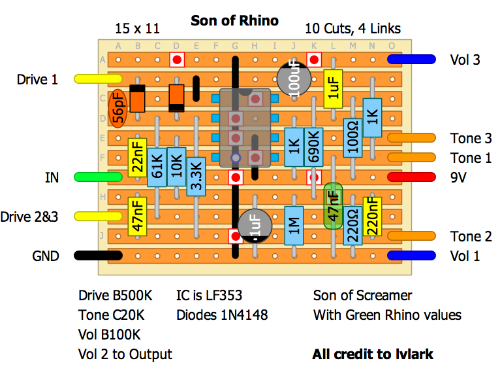Stripped Down Green Rhino...Son of Rhino?
|
Now that there is a verified schematic for the Green Rhino is if possible to make a Son of Screamer type Rhino without the buffers and extra EQ? I owned a Mk. II and it was phenomenal but I like the simplicity of the SoS and have a 1590A that is perfect for something like that (except the Stormtrooper paint job, I like that paint job).
Or is it as simple as taking the layout from the SoS and adapting it to match the Green Rhino? Thanks n |
Re: Stripped Down Green Rhino...Son of Rhino?
|
This post was updated on .
The problem with this is what you're left with IS an Son of Screamer...with some value differences.
I've copied Marks layout for the SoS but changed the component values where applicable.  Verified by squirrels Oh...the GR schematic isn't verified yet. We will have to wait till someone attempts Alex's layout and reports back |
|
I figured that much, basically another flavor of a Tubescreamer like the Lovepedal Eternity or a Muff of Fuzz Face variant. If the Mk. 2 is basically he same as the Mk. 1 with the added controls it should nail that tone, no?
Thanks for the layout. I should be giving it a shot shortly. |
|
In reply to this post by Ciaran Haslett
OK, layout works except for a few small mistakes. Drive 2 and 3 should be connected together and the connections are reversed. Also the 1uf output cap needs to go one row down spanning four rows. The only substitutions I made were the 56pf cap (used 47pf), 61k (used 68k) and the 690k (used 680k). Very trebly, like the Eternity Burst I built awhile back but pretty good. If this is close to the Mk. 1, the extra controls are worth it. Not bad though, think I'll give the Mk. 2 a go when I get some time. Thanks again.
|
Re: Stripped Down Green Rhino...Son of Rhino?
|
Oops...sorry about that. I suppose thats what can happen when you copy a layout and put little thought into it. Truth is, I didn't intend this to be a formal contribution...I'll clean it up like the others.
I had the same experience with the EB. Not too bad on its own but when used with my band it sounded really nasally. I didn't like it at all. Thanks for verifying. |
|
No problem, thanks for the layout. I did watch a few demos for the Mk. 1 and it didn't seem too far off but I have a hard time comparing pedals to demos. I did notice that an LF353 would make my SoS or EB a little more harsh sounding, I'll experiment a bit.
|
|
Haven't gotten around to IC swapping yet but this one is very sensitive to buffers. Without a buffer it's lower volume and very dull, with a buffer in front it's like you said, very nasally and much louder. Turns out the MkIV classic mode is this circuit without the extra controls. Tubescreamer buffers are only for the buffered bypass, right? I thought that's what I read on the AMZ site.
|
Re: Stripped Down Green Rhino...Son of Rhino?
|
That behaviour would be expected. On a standard tube screamer, both input and output buffers are always in the signal path regardless if the effect is engaged or not.
If you look at this schematic you can see that Q1 and Q2 are connected to the Flipflop circuit. The idea here is that Q1 turns off and Q2 turns on when the effect is engaged. Then the opposite when the effect is bypassed. But...as you can see...both buffers are always present. The switching happens after the input but before the output. Sometimes we are all so hardcore on going True Bypass that we ignore the very real benefits of buffers!...In this case, having a circuit that will sound consistent regardless of where you put it in your chain, regardless of what comes before/after it. |
|
Thanks for this, I Built this the other day and it sounds really good. Simple cheap and easy. Plus I have like 40 of the w20k pots with center detent to use up and this seems like a winner. And also I had all these weird ass values on hand already.
Btw Don't put a 1meg gain pot on it, its screams like a banshee in a bad way if you do. I upped the fb loop cap to compensate and it dulls it too much for my taste. |
«
Return to Booster, OD, Fuzz, Distortion
|
1 view|%1 views
| Free forum by Nabble | Edit this page |

